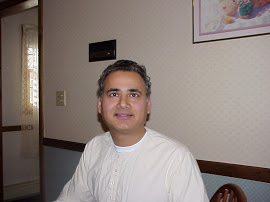Lovers Love Completely: The Goddess Mystery. By Dr. Harsh K. Luthar
Picture of Arunachala by Gabriele Ebert
Song to the Goddess
Either let me be intoxicated
in your love completely
or put on my robes of joy
and rob me absolutely.
Judge me guilty
in the court of love
or absolve me absolutely;
find me flawed if you like
but never hold me weakly.
No middle ground is possible
for lovers who love completely!
Love, Consciousness, and Bliss
The great sage of Arunachala, Sri Ramana Maharshi, used to say that all deep thinking people are fascinated by the nature of consciousness. The outer world of time and space is known only through ones’ own mind. Therefore, the mystery of mind and consciousness has been a magnet of attraction for philosopher, yogis, sages, and scientists. Upanishads say that one should know “That” by which all else is known.
What is “That”, which makes all else visible and known? The ancient philosophy outlined in the Upanishads, the sacred Hindu scriptures, refers to “That” as Sat-Chit-Ananda, the core of one’s being which is Absolute Bliss, Absolute Existence, Absolute Consciousness, and we can also say that it is the same as Absolute Love which makes all human love possible. Sri Ramana used to say that “Love is the actual form of God.”
For one irresistibly pulled by the hunger of Self-Knowledge that manifests in one’s own heart, the turning within to “That” Absolute Love and Bliss happens at some point. When consciousness spontaneously starts the process of scanning its own formless form, this churning results in the beauty and self-delight of awareness which underlies all manifestations of energy (Shakti).
Appearance of the Supreme Goddess
In many of the mystical traditions of Hinduism, the manifestations of this energy, resulting from consciousness becoming focused on its own nature, take the forms of Devi. Devi is the Supreme Goddess, who appears in visions and dreams of devotees according to their mental and spiritual condition to nurture, protect, bless, and guide them.
The Goddess is depicted in Hindu art in hundreds if not thousands of ways. This art is part of the Indian history, culture, and Hindu traditions. It comes from the inspired imagination of the artists and is based on the ancient stories about the Goddess and Her powers.
However, no artwork can really capture the form of the Goddess who appears in the mystic eye of the aspirant. She appears to each devotee in a unique way according to what best suits the nature and personality of the person at that time. As the yogi evolves in the spiritual path, the visionary forms of the Goddess can change along with that.
So a relationship develops between the devotee and the Goddess or the Divine Beloved. Like human relationships between lovers, it is not always easy.
Sometimes, the devotee cannot bear the separation and wants immediate union and consummation. He may even blame and question the Goddess as to why She has left him in the middle of the path after taking his hand.
Song of Despair to the Goddess
Play hide and seek
not too much longer
and risk this longing
get even stronger;
when people ask unashamedly
why your love flees from me
what honest answer can I make
and can you also say for sure
that in choosing me as your lover
you have made some grave mistake.
But the Goddess realizes that it is not time and waits for the moment to be ripe for the final liberation. Many of the love poems of mystics to the Goddess have come from this intermediate level of spiritual experiences where the Supreme Beloved appears to plays hide and seek with them.
Sri Ramana and Marital Garland of Letters
In the classic Tamil poem, “The Marital Garland of Letters” the Sage of Arunachala, Sri Ramana Maharshi, chides the Divine Beloved in some of the verses and apologizes for having done so in other verses. He begs Arunachala to fully embrace him (as the devotee) and utterly consume him in love; Because only then he will have peace.
Ramana writes:
Verse 23. “Sweet fruit within my hands, let me be mad with ecstasy, drunk with the bliss of Thy essence, Oh Arunachala!”
Verse 34. “Unless Thou embrace me, I shall melt away in tears of anguish, Oh Arunachala!”
Verse 60. “In my unloving self Thou didst create a passion for Thee; therefore forsake me not, Oh Arunachala!”
Hindu Mystical Bhakti Poetry
The love pattern of alternating between despair and ecstasy (Does She/He love me or love me not), joy and sadness (When will the Goddess/Divine Beloved visit again) is common in the poetry of many Hindu saints and mystics. Even the seeming confusion about the relationship itself, which makes the devotee beg sometimes for love and other times actually blame, chide, and command the Goddess/Divine Beloved, can be seen in some of the poems including the Marital Garland of Letters.
Although the Marital Garland of Letters by Sri Ramana is embedded in the Indian spiritual, historical, and cultural context, the symbolism of a lover who is in complete despair because of an incomplete consummation with her/his beloved is universally understood.
Summary
People who are in love with and fascinated by the mystery of consciousness have felt that mysterious pull of the Heart from within themselves. Who can really explain ways of the Divine and the different forms She/He manifests in.
What is the first step on this path of love? No one can say for sure. Was it the smile and look of a Sage, the grace of the Divine Mother, the kiss of the Goddess, or the kindness of a teacher or a friend? There must be many possibilities that make us aware of the Heart within, whose nature is Sat-Chit-Ananda, that which is the source of the ultimate bliss.
This memory once awakened brings upon the experience of pure being, and attracts the devotee to the truth of her/his own nature. This gentle pull within makes itself felt. It does not let go until the Truth of one’s own Heart is recognized, and there is nothing left to let go.
Some say that it is the Goddess Herself, who takes the devotee into the Heart and then reveals Herself as the Universal Heart. The complete identity between the devotee, the Goddess, and the Heart thus established, everything disappears. There is only that Heart of Love and Fullness, eternal consciousness completely at rest in its own nature.
Knowing That is Self-Knowledge. That is the final consummation.
“I came to feed on Thee, but Thou hast fed on me; now there is peace, Oh Arunachala!” Verse 28. Marital Garland of Letters.
NOTE: Some of the verses on the Goddess in this article are from a longer poem on the Goddess by Dr. Harsh K. Luthar.


Reblogged this on Luthar.com and commented:
The Goddess Mystery in the Yogic Tradition
LikeLike
Thank you for this…brings to mind my own wonderful teacher Eve Galitzine. I still think of her after 30 years! Amazing, amazing, spiritual being who i am forever indebted to. Although unable to recognize her greatness at the time, even though miracles happened all around her, I do ” get it” now. She was all love and compassion and thus your post is a timely reminder of her.
LikeLiked by 1 person